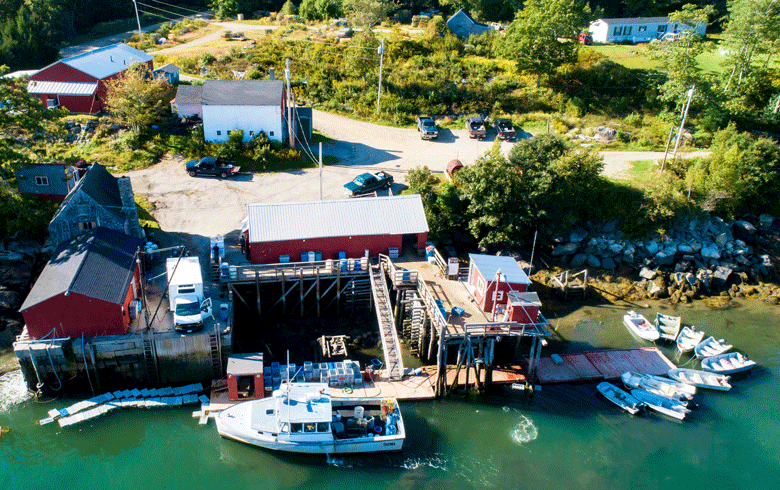Persuading policy makers and residents of the value of Maine’s “blue economy” is easy, but if significant investment isn’t made in commercial access to the shore, that sector will languish, according to a report published late last year.
“The Critical Nature of Maine’s Working Waterfronts and Access to the Shore” was researched and compiled by Merritt Carey and commissioned by the Island Institute, publisher of The Working Waterfront. Carey interviewed more than a dozen sources, including harbormasters, fishermen, aquaculturists, and municipal and marine patrol officials.
In commissioning the report, the Institute cites pressure on access to the shore that will come as ecosystems, economies, and fisheries change. To keep ocean-based ventures vital, a concerted and comprehensive approach to preserving access is needed, the report asserts.
“Once access points are gone, they do not come back,” the report warns.
There is much at stake.
The lobster industry generates more than $1 billion in economic activity, according to a 2018 Colby College study. “Considerable growth” in aquaculture, coupled with a healthy scallop fishery, and the less visible but steady harvests of groundfish, clams, seaweed, and worms, means pressure by users will not abate.
“Once access points are gone, they do not come back.”
The marine-based economic activity on its own is compelling, Carey writes, but more should be considered in weighing the value of a healthy working waterfront—the millions of dollars tied to tourism.
“Those who flock to our shores to consume lobsters and steamers, to visit our oyster trail, who stand mesmerized as they watch fishermen unload their catch” also benefit from the working waterfront.
“Any way you measure, whether raw economic data, heritage and history, or community, Maine’s working waterfront and our ability to earn a living on the water is integral to who we are, and who we should be,” the report asserts.
Access protection is urgently needed and the best response is a statewide action plan, the report concludes.
“Maine’s current system for working waterfront protection does not solve all challenges, nor does it apply to all circumstances or locations,” Carey writes. “Instead, we have a system that is a kernel of something we should build around.”
The state budget approved in July dedicates at least $4 million to working waterfront protection through the Land for Maine’s Future program, but Carey’s report argues that “long-term, systemic interventions that recognize the place-based nature” of commercial access are needed, and that the best way to deliver those interventions is to create an entity that looks at the pressures wholistically and can provide technical and resource assistance.
The report calls for establishing a statewide foundation or agency led by stakeholders that works to protect access, but also works to market seafood, influence regulations and policy, and join in climate change work.
FOR SALE
Not surprisingly, a force threatening commercial access to the waterfront is the escalating value of shorefront property. The median price of single-family homes sold in Maine increased by 13.8 percent in 2020, with 30 percent of homes sales made to out-of-state buyers.
These numbers “underscore a long-existing trend of coastal real estate becoming too expensive for local residents to afford,” the report notes, along with bringing residents who “may not understand or appreciate the importance of our marine industries.”
One scenario Carey offers explains the delicate nature of commercial access to an increasingly developed coast: “A single clammer without access … will use an airboat. The noise will likely lead to bad relations with neighbors and waterfront owners … [which] leads to competition for space and resources.”
What follows are crowded boat launches and wharves, she writes.
Most at risk are privately owned access points, which “have long provided overland access to the shore … on a handshake.” When these properties are sold to those with no relationship with users, access is lost.
Another impact of the real estate market that Carey reveals is residential requirements for clamming licenses—even rentals are hard to come by in some southern coastal towns.
Lobstering becomes more difficult when the coast is unaffordable as fishermen must haul gear and bait farther from their homes to piers.
The report also notes that climate change will make maintaining waterfront infrastructure more expensive, with damage from storms and higher flood insurance premiums.
Carey lists the key programs that help protect commercial access, but notes that, in the case of the Land for Maine’s Future, “funding is erratic,” and the process is passive in that it accepts applications—for which those in the fishing industry are not skilled in completing—instead of seeking to protect key properties based on analysis.
“There is not a comprehensive statewide plan outlining what geographic areas or what types of working waterfronts are most at risk,” she writes.
Maine has 84 land trusts, with 62 in the state’s eight coastal counties. All aim to protect land for recreational use.
“There is not a single entity in Maine whose sole mission is to protect and retain working waterfront,” the report notes. It acknowledges the complexity of public institutions securing high-value real estate for private ventures but pulls no punches.
“Without a comprehensive, statewide plan … Maine will never move beyond its current approach,” which the report derides as inconsistent. And it argues that economic opportunity would be squandered.
“Without access, the touted ‘blue economy’ cannot be realized.”
The full report is available at:
islandinstitute.org/get-involved/save-maines-working-waterfront/





